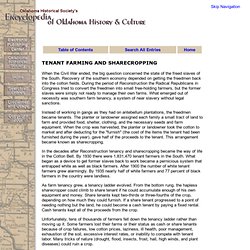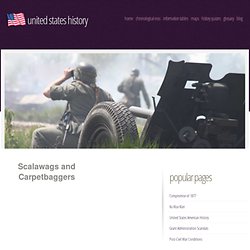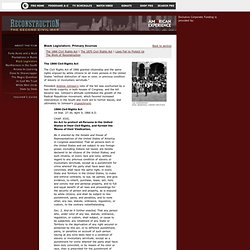

<i>The Doom of Reconstruction: The Liberal Republicans in the Civil War Era</i>. Find using OpenURL The Doom of Reconstruction: The Liberal Republicans in the Civil War Era (review) In lieu of an abstract, here is a brief excerpt of the content: This study of the liberal republican movement provides a sympathetic treatment of a small group of Republicans who were the founders of a challenge to the Republican party and the Ulysses S.

TENANT FARMING AND SHARECROPPING. When the Civil War ended, the big question concerned the state of the freed slaves of the South.

Recovery of the southern economy depended on getting the freedmen back into the cotton fields. During the period of Reconstruction the Radical Republicans in Congress tried to convert the freedmen into small free-holding farmers, but the former slaves were simply not ready to manage their own farms. About Sharecropping. About Sharecropping SharecroppingTrudier Harris A practice that emerged following the emancipation of African-American slaves, sharecropping came to define the method of land lease that would eventually become a new form of slavery.

Without land of their own, many blacks were drawn into schemes where they worked a portion of the land owned by whites for a share of the profit from the crops. Scalawags and Carpetbaggers. A temporary political vacuum existed in the postwar South.

Confederate military and political leaders were temporarily prohibited from participating in the political process. Republican governments filled the void and were able to retain control by depending upon the votes of the newly enfranchised blacks. Blacks were vital to the process, but that did not mean that they ran affairs. Two groups actually pulled the strings of government: Scalawags — a derogatory term (originally describing worthless livestock) applied to native white Southerners who supported the federal reconstruction plan and cooperated with the blacks in order to achieve their ends.
Carpetbaggers & Scalawags - American Civil War. In general, the term “carpetbagger” refers to a traveler who arrives in a new region with only a satchel (or carpetbag) of possessions, and who attempts to profit from or gain control over his new surroundings, often against the will or consent of the original inhabitants.

After 1865, a number of northerners moved to the South to purchase land, lease plantations or partner with down-and-out planters in the hopes of making money from cotton. At first they were welcomed, as southerners saw the need for northern capital and investment to get the devastated region back on its feet. They later became an object of much scorn, as many southerners saw them as low-class and opportunistic newcomers seeking to get rich on their misfortune. 15th Amendment. 14th Amendment to the U.S. Constitution: Primary Documents of American History (Virtual Programs & Services, Library of Congress) Reconstruction: The Second Civil War.
The Civil Rights Act of 1866 granted citizenship and the same rights enjoyed by white citizens to all male persons in the United States "without distinction of race or color, or previous condition of slavery or involuntary servitude.

" President Andrew Johnson's veto of the bill was overturned by a two-thirds majority in both houses of Congress, and the bill became law. Johnson's attitude contributed the growth of the Radical Republican movement, which favored increased intervention in the South and more aid to former slaves, and ultimately to Johnson's impeachment. 1866 Civil Rights Act 14 Stat. 27-30, April 9, 1866 A.D. CHAP. Ku Klux Klan. The Ku Klux Klan, with its long history of violence, is the most infamous - and oldest - of American hate groups.

Although black Americans have typically been the Klan's primary target, it also has attacked Jews, immigrants, gays and lesbians and, until recently, Catholics. Over the years since it was formed in December 1865, the Klan has typically seen itself as a Christian organization, although in modern times Klan groups are motivated by a variety of theological and political ideologies. Started during Reconstruction at the end of the Civil War, the Klan quickly mobilized as a vigilante group to intimidate Southern blacks - and any whites who would help them - and to prevent them from enjoying basic civil rights. Outlandish titles (like imperial wizard and exalted cyclops), hooded costumes, violent "night rides," and the notion that the group comprised an "invisible empire" conferred a mystique that only added to the Klan's popularity.
Klan glossary. Reconstruction - American Civil War. At the outset of the Civil War, to the dismay of the more radical abolitionists in the North, President Abraham Lincoln did not make abolition of slavery a goal of the Union war effort.

To do so, he feared, would drive the border slave states still loyal to the Union into the Confederacy and anger more conservative northerners. By the summer of 1862, however, the slaves themselves had pushed the issue, heading by the thousands to the Union lines as Lincoln’s troops marched through the South. Their actions debunked one of the strongest myths underlying Southern devotion to the “peculiar institution”–that many slaves were truly content in bondage–and convinced Lincoln that emancipation had become a political and military necessity.